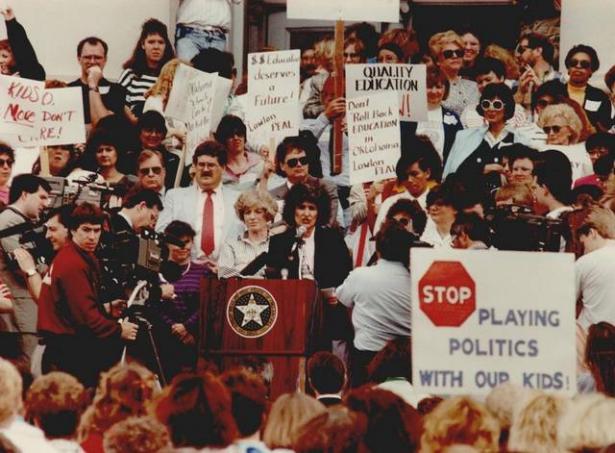A half-dozen top leaders of the Oklahoma Education Association gathered in a room looking to make the final call on whether educators across the state should walk off the job in protest over low school funding and teacher pay.
“We talked about what options there were ... but at that point, the only option left to us was to call for a work stoppage,” OEA Executive Director David DuVall recalled.
It was April 1990.
A four-day showdown ensued, with the state Legislature later approving a series of tax increases that sent new money to teacher salaries and school budgets, along with establishing a variety of education reforms.
Fast-forward 28 years and Oklahoma educators again face funding and pay challenges that have teachers threatening an April 2 walkout if lawmakers fail to provide more than $800 million in new funding for public schools and state employees next fiscal year.
But as teachers prepare for another April walkout, there are some key differences when compared to 1990, which present unique challenges, along with unique opportunities.
A grassroots social media push by educators in recent weeks likely helped push the OEA to set an April 2 deadline for a series of school funding requests or teachers would strike.
"We have to be united and social media has really achieved that," said Alberto Morejon, a Stillwater teacher and founder of a Facebook group called Oklahoma Teacher Walkout — The Time Is Now!, which has nearly 50,000 members.
"My goal was to create a place where we could have a discussion and I think that helped spur some momentum."
The teacher strike of 1990 was void of Twitter hashtags, Facebook discussion groups and other social media tools that bring a level of immediacy to sharing information and mobilizing around an issue.
"I've been part of the groups that have gone to the Capitol over the last three years and rallied, and I've called my lawmakers," said Amy Whitewater, a teacher in Woodward. "But it just feels like in the last couple of weeks we've had a lot of momentum and I think that's been mostly because of social media."
On Wednesday, Whitewater wrote an impassioned letter on her Facebook page, where she has also changed her profile picture to a box that says "The time is April 2."
"The years of working in these conditions have been disheartening, but I am a determined hometown girl who wants to raise my children in the same community I enjoyed throughout my youth," Whitewater's post said.
Within hours it had received hundreds of likes, comments and shares.
"My (Facebook) message inbox was bombarded and coming to school this morning a mom stopped me and said she read my post and agreed with me," Whitewater said. "Social media has been a big part of this and I think it helped get us to this point."
If teachers strike next month it will be a movement fueled by technology in a way the walkout of 1990 never was.
But one thing the 1990 walkout had going for it was a specific piece of legislation before lawmakers that teachers were able to rally around.
Earlier this week, the OEA proposed a package of pay raises for school and state employees, along with increased funding for public schools, totaling around $1.4 billion in new spending. They are requesting more than $800 million to be funded next fiscal year.
"If the Legislature cannot properly fund education and core state services by the legal deadline of April 1, we are prepared to close schools and stay at the Capitol until it gets done," said Alicia Priest, president of the Oklahoma Education Association.
But those proposals have not yet materialized into a proposed bill.
"Defining the win is really important when you are in these positions," DuVall said. "At that point (in 1990) the win was fairly simple, you have to pass this bill."
In 1990, the Legislature had passed House Bill 1017 with a simple majority, but it failed to reach the two-thirds threshold necessary at the time to immediately implement the reforms and taxes, leaving the door open to a likely challenge and delay.
Today, educators face an even steeper hill as any revenue-raising measure out of the Legislature requires a three-fourths vote.
"I think it is very important that these teachers realize that half of the (state) House of Representatives is on their side and has voted for pay raises before," said Rep. Rhonda Baker, who was a Yukon teacher before her election to the state House.
A tax hike package in February that would have funded a $5,000 teacher pay raise was defeated in the House, despite the fact that 63 out of 101 members voted in favor — The bill needed 76 votes to pass.
Baker, R-Yukon, said there are still efforts in the Legislature to find a way to pay for an increase in teacher pay. But she understands the frustration teachers are feeling.
"April 2 is coming in less than a month and if teachers feel that is what they must do then I understand that," Baker said. "But it is a minority of members in the House that has held us up."


Spread the word